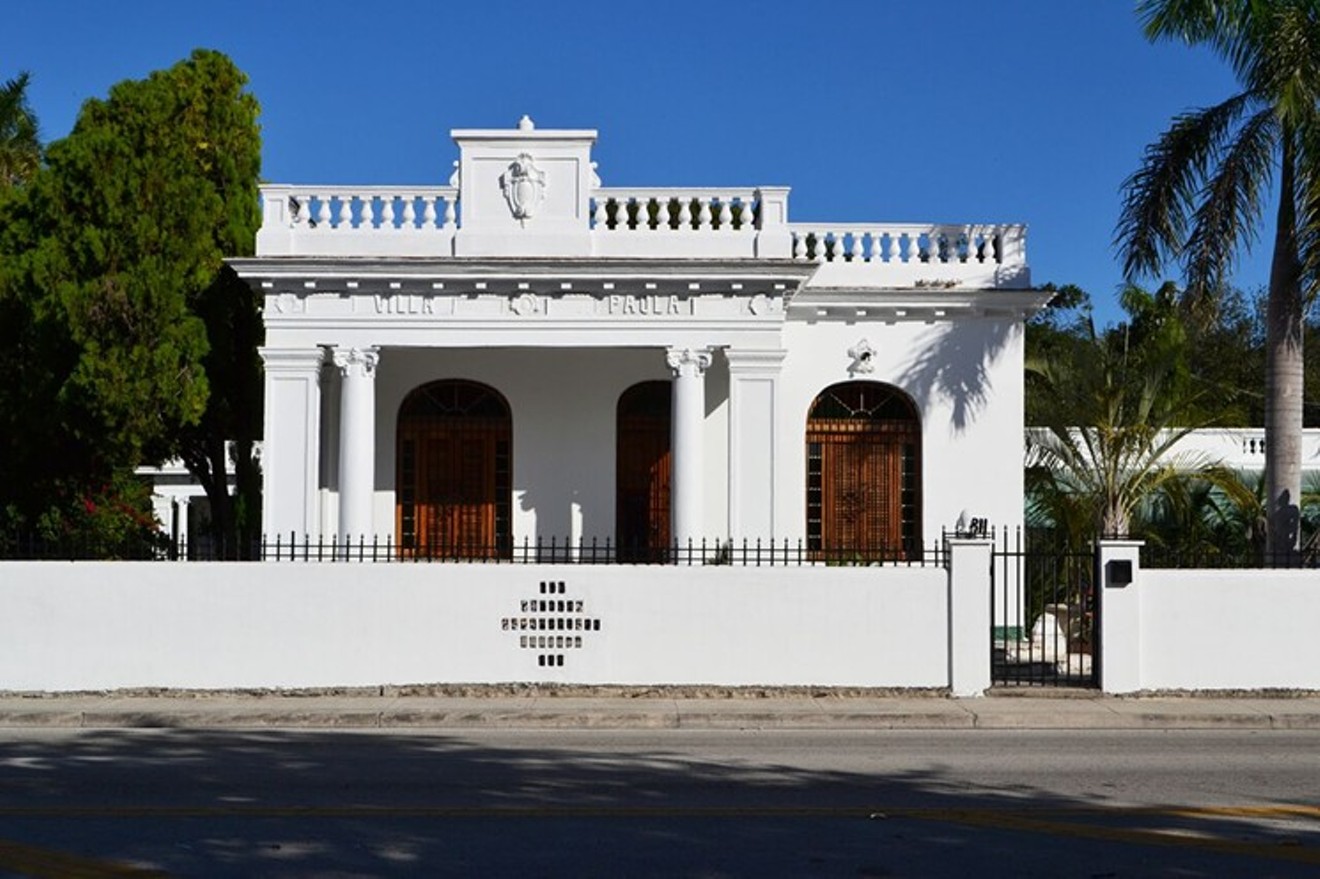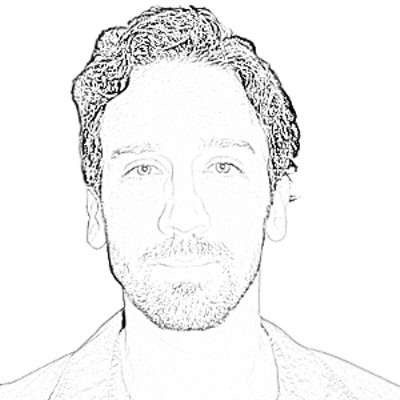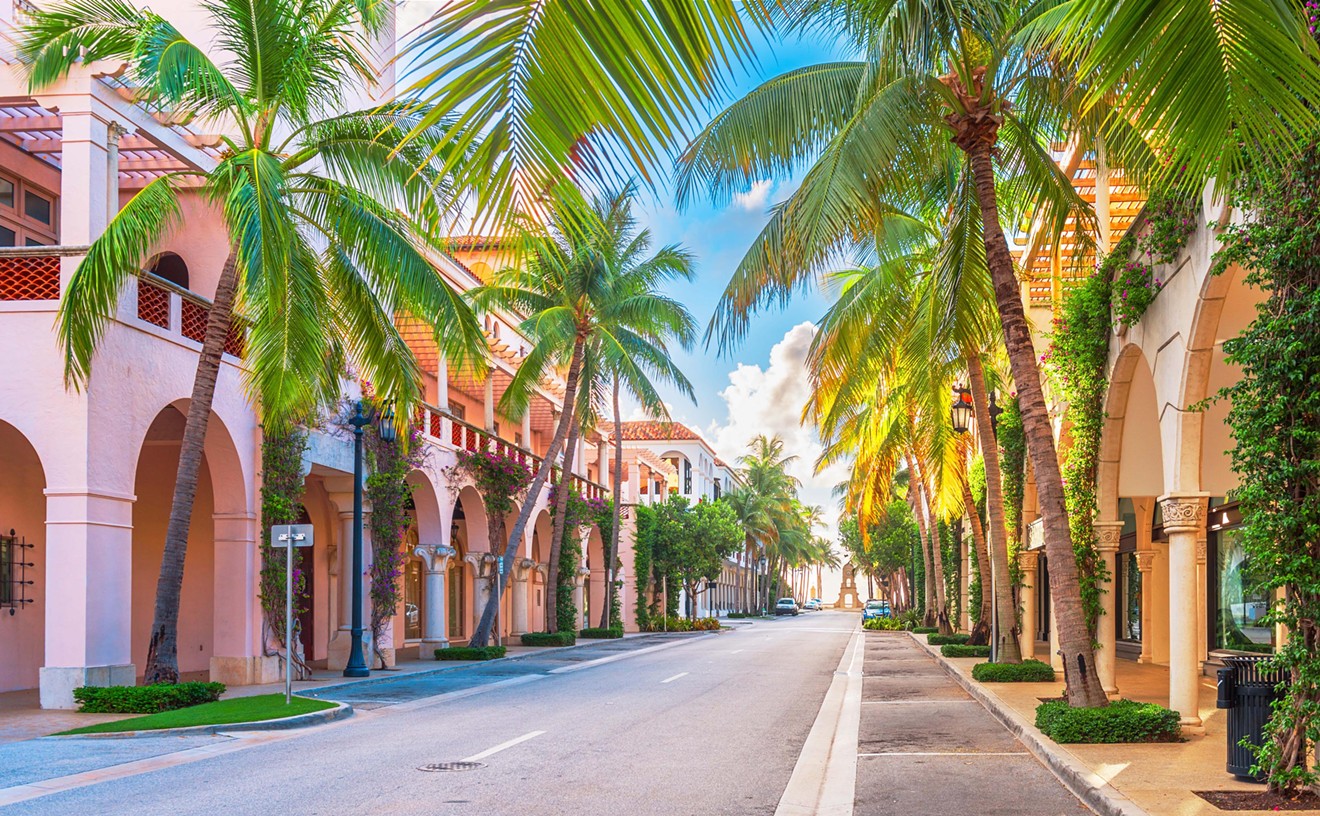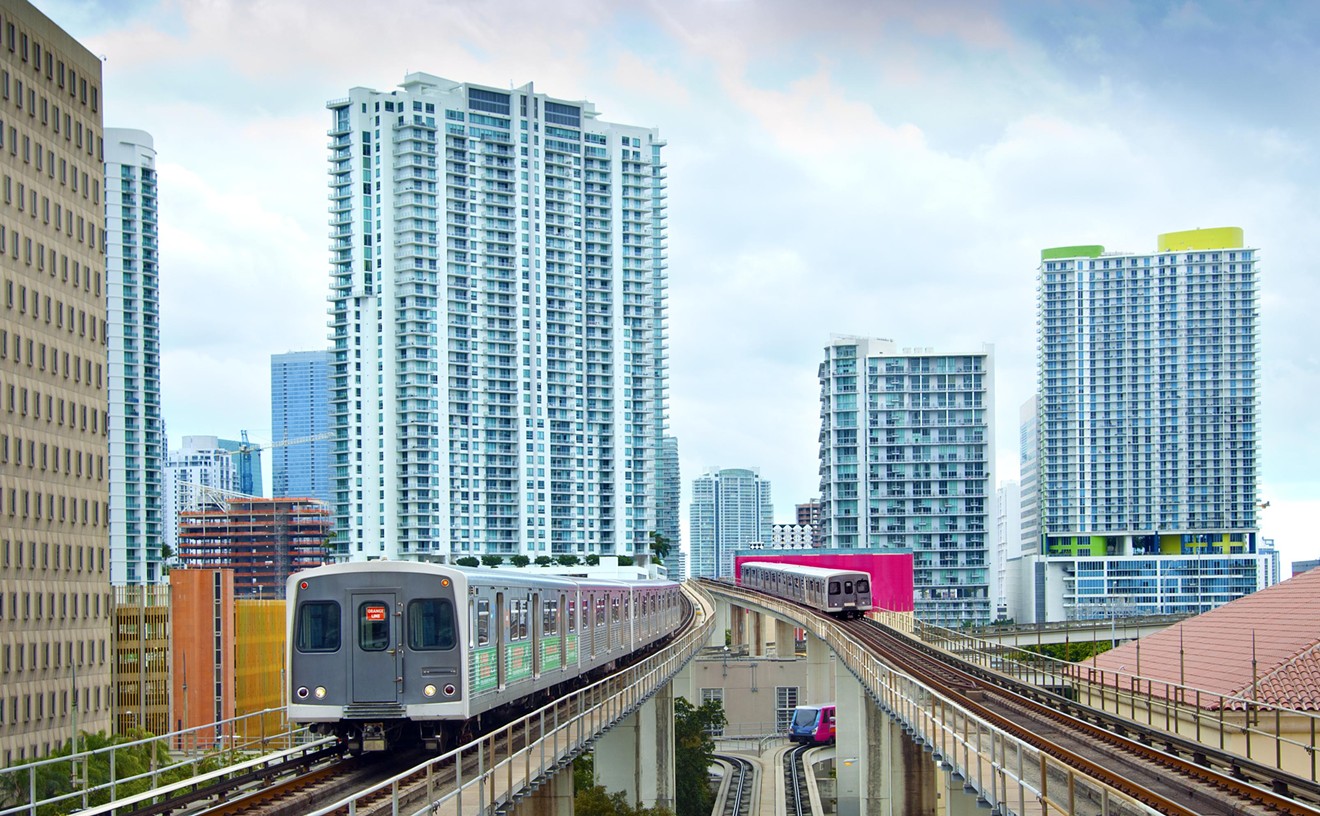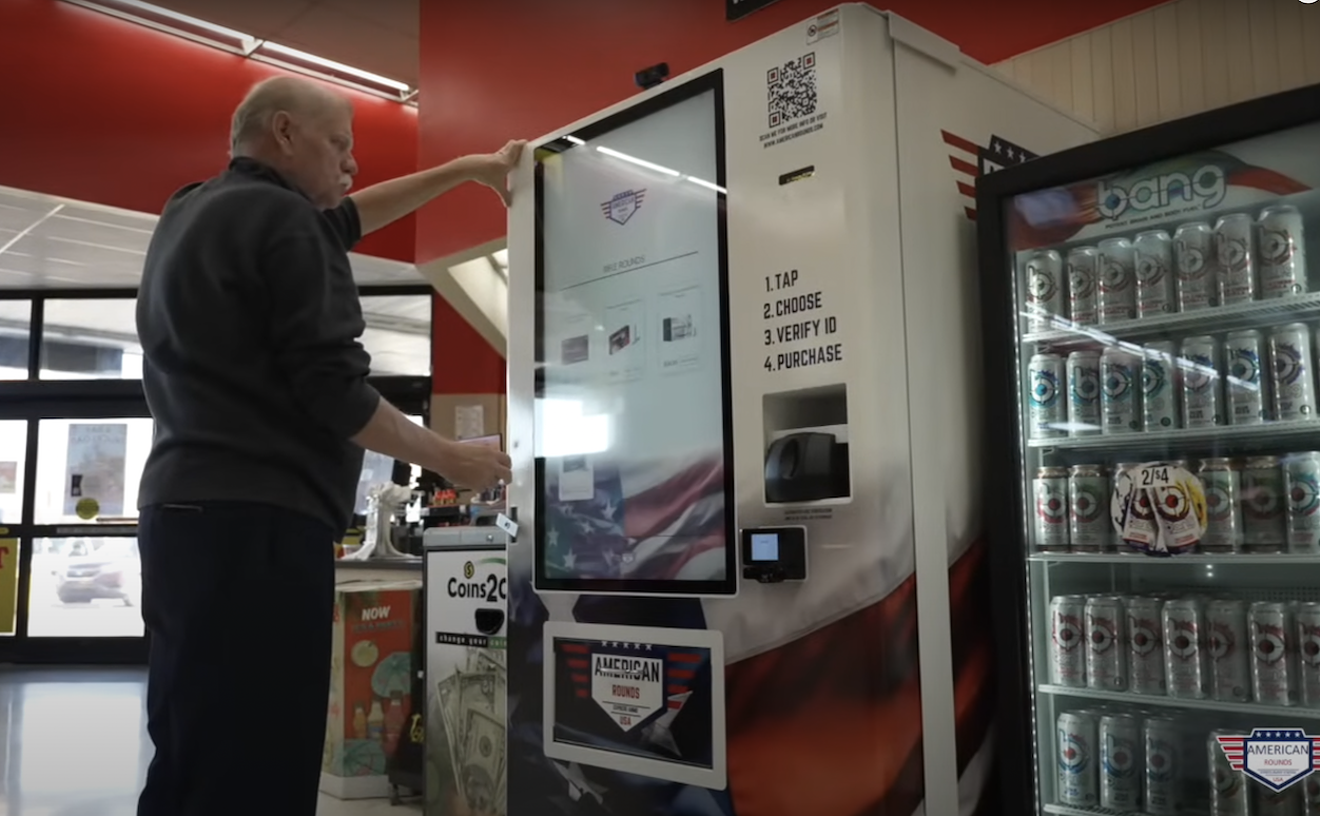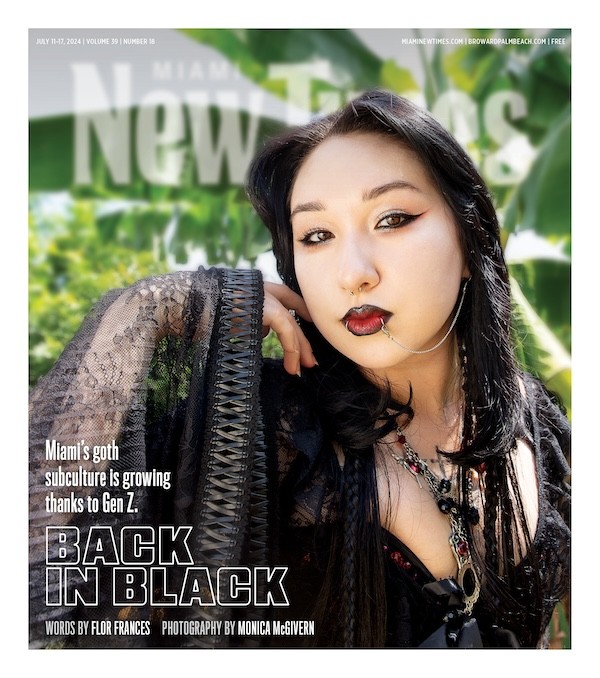Only a concrete sarcophagus in the corner of the backyard avoided a soaking. The thick roots of a ficus tree had grown over it, gripping it claw-like and funneling away the downpour.
It would take a chainsaw to free the box and a sledgehammer to solve the mystery of what — or who — is inside it.
Local lore holds that the sarcophagus contains the remains of Villa Paula's first resident and namesake, Paula Milord. But like many a Miami story, the details are as shifty as the fall weather.
Paula moved into the house at 5811 N. Miami Ave. around 1927 shortly after it was built. It makes sense that she would never want to leave. With ten rooms at the time, two baths, 18-foot ceilings, hand-painted floor tiles, and Tuscan columns, Villa Paula was a Cubanesque neoclassical mansion in the middle of the then-quiet agricultural burb of Lemon City (now Little Haiti).
It was built to house the Cuban consulate to Miami. Paula's Cuban-born husband, Domingo Milord, had been sent from Key West, where he grew up, to serve as consul. Paula, also born in Cuba, accompanied him to the young city of Miami. Both were in their 50s.
Domingo loved his wife so much, the story goes, he christened the live-work mansion "Villa Paula" and had the name installed in stucco letters above the front door, where it remains today.
When Paula died a few years later from complications related to a leg amputation, legend has it Domingo kept her close — very close. He placed her in a concrete sarcophagus in the backyard, embedded a turquoise crucifix into its façade, and topped it with two Grecian urns. His true love would rest in peace just outside the window of the bedroom they once shared.
In life, Paula is said to have played the piano, brewed seemingly endless Cuban coffee, and swished around the house in an ankle-length dress. In death, she apparently continued on as if nothing had changed. Beginning in the 1980s, newspapers began reporting that residents of the home heard a piano, smelled coffee, and saw a dark-haired, one-legged lady floating in the home's chandeliered hallway. Paula, they all said, was a lingering and restless soul.
No one, however, ever mentioned a grave in the backyard.
Then, about four years ago, Boca Raton businessman Richard Siskind bought Villa Paula from his brother Martin, who had turned it into an art gallery and cultural venue a few years earlier. (Martin still manages it.) Around that time, Villa Paula's website began inviting visitors to stop by and "hear stories about the original owner, Consul General Don Domingo Milord and his wife Paula, who died tragically after a leg amputation and was buried in the garden."

Is a former resident of historic Villa Paula really entombed in the backyard sarcophagus?
Photo by Terence Cantarella
However, there's a problem with this gothic story of subtropical romance.
City and county records show Paula moved out of the home in 1930. According to public death records, she died August 25, 1932 — two years later. Furthermore, obituaries in the New York Times and Key West Citizen reported at the time that Paula was buried at Miami's Woodlawn Cemetery on SW Eighth Street.
End of story? Not quite.
Woodlawn confirms Paula was buried at the cemetery in grave number 1115, Section 27. Yet when a groundskeeper escorted a New Times reporter to her grave, there was no headstone. Nearby, meanwhile, were dozens of well-maintained headstones belonging to people who died the same year as Paula.
"She's here, 120 percent," the groundskeeper said, pointing at the grass. "We have thousands of people here with no markers."
Asked if there's a way to confirm the presence of a coffin underground, perhaps with a soil probe, the groundskeeper chuckled and said no.
So is Paula really buried there? More important, would her husband, the esteemed Cuban consul to Miami, really have interred his wife of nearly four decades in a cemetery with no relatives, in a city in which she had lived for only six years?
Where, then, is Paula Milord? And who is entombed behind her former home?
Shortly after Paula's death, Domingo moved back to Key West. He died there five years later, on November 23, 1937, and was buried at the historic Key West Cemetery.
Paula might be buried next to him. Trouble is, his headstone too is missing.
Russell Brittain, a sexton at Key West Cemetery, confirms Domingo Milord is registered there. But there's no headstone bearing his name and no grave location number in the records. That would suggest, Brittain says, he was buried in a pauper's grave.
Domingo, though, was no pauper. Brittain, meanwhile, has no record of Paula.
The online database Find a Grave shows 30 Milords and 128 Toledos — Paula's maiden name — buried in cities across Florida. Some are Paula's relatives, but not one is her.
Refrigerated transport arrived in the 1930s, and Paula's remains could have been sent south via the Florida East Coast Railway, loaded onto a ferry, and buried in Havana alongside relatives. Her father, for one, was killed in a duel there in 1874.
Cementerio de Cristóbal Colón in Havana, where most Cuban dignitaries are buried, however, has no record of Domingo or Paula.
Newspaper archives show the Milords lived at two other addresses in Miami after leaving Villa Paula in 1930: 1552 NE Miami Ct. and 59 NE 11th Ter. Paula died at Jackson Memorial Hospital in 1932.
Could Paula, then, have been taken back to the home adorned with her name and laid to rest there?
Dr. Lord Lee-Benner, a retired anti-aging doctor in West Palm Beach, lived in Villa Paula in the 1940s and '50s. His grandmother Helen Reardon owned the home from 1930 to 1970. He says Paula's sarcophagus was not present when he was a child.
"That has to be something new," Lee-Benner says. "That was never there."
As for a ghost, he never saw one.
"That's, of course, foolishness," he says, laughing. "It's a big house — big, heavy doors. There could be creaking noises maybe, wind going through. People can make up any kind of story they want, but it would be a stretch."
It was a later resident, in fact, who first made the paranormal claims. Cliff Ensor bought the place in 1974 and began recounting tales about the sound of heels clacking around the house, silverware being thrown about, and a chandelier crashing to the floor. In 2008, at 81 years old, he told the Biscayne Times he stood by those past accounts.
"The house is definitely haunted,” Ensor said at the time. "Emma, the medium, used to hold séances in there every two weeks. This woman couldn't play the piano at all, but one day she channeled a spirit and began to play like a pro."
Ensor, however, never mentioned a grave. A 1983 City of Miami Planning Department report about the property, which was written at Ensor's behest and led to the home being designated historic, also made no reference to it.
What, then, is in that backyard box, and does it contain human remains?
Fashion designer Fernando Garcia rented the home for three years in the early 2000s. He's not sure when the backyard structure was built but believes it's simply an altar or shrine. "There was probably a little saint statue there at some time," he says. "Back in the day, people liked to have little shrines."
The box, he says, doesn't have a removable lid and is too small for an adult. He often told people as much, but many visitors still wanted to chant and pray at what they thought was Paula's grave anyway.
Pediatrician Lucien Albert, who ran a clinic out of the home for more than a decade before Garcia lived there, couldn't be reached at several numbers listed for him and his family. Some residents have speculated, however, that the backyard structure could have been built during his time there.
Artist Joe Chirichigno recently lived at Villa Paula for six months and is still the resident artist there. He says he had many bizarre experiences in the home but is reluctant to share them publicly because of the stigma attached to paranormal claims. He agrees, however, that Paula is not buried in the backyard.
“It's not Paula's grave," Chirichigno says. "It's not even a grave at all."
Chirichigno's research and experiences have led him to doubt the narrative that Paula and Domingo were a loving couple. He believes Paula is, indeed, buried at Woodlawn Cemetery. She has no headstone there, he surmises, "because that was the way Domingo wanted it."
He could be right. A 1932 Miami Herald obituary for Paula noted that "more than 200 persons, including prominent Miamians and members of the Miami Cuban Colony, attended funeral services" for her in Miami. Her remains, presumably, were at that service — making a Miami burial likely.
Today, Villa Paula and its connected properties are on the market. Real-estate broker Jean Louis Delbeke is tasked with selling the lot for $4.5 million. He wrote via email that he "cannot verify any story on Paula" and put New Times in touch with Martin Siskind, the brother of Villa Paula's owner. Siskind didn't respond to emailed questions about the origin and contents of Paula's supposed grave.
Back at Villa Paula, meanwhile, the autumn rain has subsided, leaving the whitewashed home shining in the sun. Paula's story, however, is unlikely to fade as quickly. The enchantment of a lover's grave behind a neoclassical mansion, in a city built on extravagant real-estate tales, is just too good to let go.
There might even be something interesting under that mysterious ficus-covered box. Sadly, it's not Paula.

